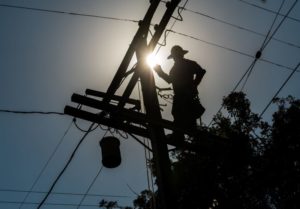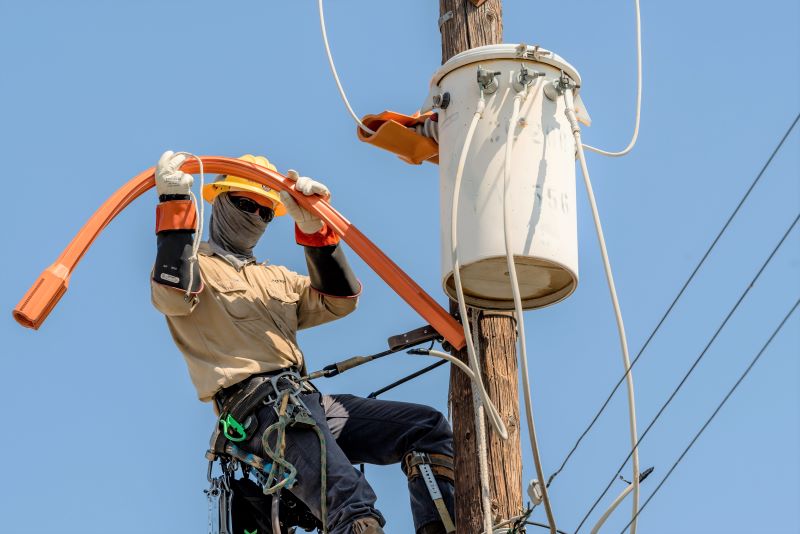
LADWP Helps State Avoid Rolling Blackouts While Keeping Power Flowing for L.A. During Extreme Heat Waves
By Carol Tucker
Amid record-setting temperatures and soaring demand for electricity by sweltering Southland residents, LADWP provided nearly 43,700 megawatt-hours (MWh) of emergency power to state and local grid operators in California in August and September, as well as Arizona in August, to keep the power flowing for over 20 million customers.
Electric customers in Southern California and Arizona benefitted from the foresight of LADWP’s long-term energy planning for redundancy in generation and transmission, and dispatchable power that can be quickly ramped up to meet peak demand.
“It was very gratifying to be able to assist other utilities and help avoid more outages during this heat storm,” said LADWP General Manager and Chief Engineer Marty Adams. For over a century, LADWP has invested in developing and securing its own power generation and transmission resources. “We have always placed reliability first and foremost in our planning, maintenance and operations, even as we transition to a greater mix of renewable energy,” Adams said.

Photo by Chris Corsmeier
Over the Labor Day weekend, LADWP provided an estimated 11,215 MWh of excess power to the California Independent System Operator (CAISO), which operates much of the statewide grid powering communities and cities served by investor-owned utilities. CAISO was forced to declare Stage 2 emergencies on September 5 and 6, which meant power outages were possible due to increased demand and reduced supplies, but the state agency was able to avoid rolling blackouts during the September heat event.
From September 4-7, LADWP supplied emergency power to the municipal utilities of Burbank (550 MWh), Glendale (393 MWh), and Imperial Irrigation District (725 MWh).
Although the state did institute the first rolling blackout since 2001 on August 15, 2020 and to a lesser extent on August 16, 2020, LADWP was fully resourced and able to help CAISO avoid similar impacts. LADWP provided 10,450 MWh to CAISO from August 13-19 – primarily during peak periods in the late afternoon and evening when solar output is reduced, yet demand for electricity to power air conditioning and other customer uses remain high. LADWP also provided 2,755 MWh to Arizona communities served by the Salt River Project after a major transmission line failed, and smaller amounts to Glendale and the Imperial Irrigation District.
LADWP maintains in-basin and out-of-basin power plants, including 34 percent renewable energy, along with a vast transmission system representing 25 percent of the state’s power transmission assets. Like other public utilities in the state, LADWP benefits from being a “vertically integrated” utility, owning its generation, transmission, and distribution, and has not had to initiate rolling blackouts related to lack of power.
LADWP also owns and operates a significant amount of dispatchable power generation, such as the Castaic Pumped Storage Hydroelectric Plant in northern Los Angeles County. Dispatchable power can be ramped up quickly when needed to meet energy needs, especially as the sun goes down and solar power is no longer available.
While dispatchers were busy shipping energy to customers throughout the region and state, electric distribution crews worked around-the-clock to restore power to nearly 110,000 LADWP customers within 24 hours during the record-breaking heat storm over Labor Day weekend. Heat-related equipment failures triggered outages for more than 128,300 out of LADWP’s 1.5 million electric customers. The vast majority, about 85 percent of all affected customers, had their power restored within 24 hours, and about 99 percent were restored within the 48-hour timeframe allowed under a Level 3 storm situation.

An LADWP lineman works on a transformer during Labor Day heat storm. Photo by Chris Corsmeier
Most of the outages lasting 24 hours or longer were related to equipment failures at the neighborhood level, as distribution equipment became overheated and overloaded. Local distribution stations also overheated, leading to larger circuit outages affecting multiple neighborhoods. In some neighborhoods, equipment was running 200 percent of its maximum capacity due to extreme heat and demand.
“Restoring neighborhood outages affecting groups of five to 20 homes takes our crews much longer than larger circuit level or partial circuit outages, where a single crew may be able to restore power to 500 – 1,000-plus customers in the same amount of time,” said Andy Kendall, Senior Assistant General Manager of Power Construction, Maintenance, and Operations. In contrast, neighborhood outages typically take a single crew four to six hours to restore power to a much smaller group of customers.
To put these numbers in context, LADWP’s system fared much better compared to similar heat events in 2017 and 2018, Power System officials said. In 2017, a total of 317,700 customers experienced power interruptions.
LADWP officials attributed the improvement to aggressive investments in power infrastructure—approximately $3.7 billion from fiscal year 2016-17 through fiscal year 2019-20, with over $1 billion is budgeted this year. Moving forward, LADWP will look at ways to increase replacement targets in the next five years and analyze the impact of climate change on power demand.
#
Featured photo by Chris Corsmeier